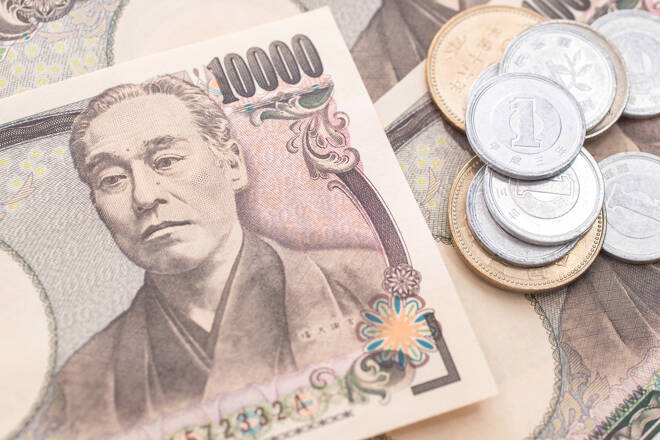Advertisement
Advertisement
USD/JPY Forecast: Trade Data and the Services PMI from Japan in Focus
By:
After the Bank of Japan monetary policy decision and press conference, services sector prices and employment PMIs could influence BoJ pivot bets.
In this article:
Highlights
- The USD/JPY gained 0.13% on Tuesday, ending the session at 148.283.
- Bank of Japan Governor Ueda discussed conditions needed to exit negative rates, influencing the USD/JPY pair.
- On Wednesday, trade data and private sector PMIs from Japan warrant investor attention before the US session.
USD/JPY Movement on Tuesday
The USD/JPY gained 0.13% on Tuesday. Following a 0.05% loss on Monday, the USD/JPY ended the day at 148.283. On Tuesday, the USD/JPY fell to a low of 146.972 before rising to a session high of 148.695.
Trade Data and Private Sector PMIs Put the Yen in the Spotlight
On Wednesday, trade data from Japan will garner investor interest early in the session. Improving trade terms could ease BoJ board member concerns about the economy and raise bets on a Q2 pivot from negative rates.
Economists forecast the trade deficit to narrow from ¥776.9 billion to ¥122.1 billion in December. Significantly, economists expect exports to increase 9.1% year-over-year versus a 0.2% decline in November.
However, preliminary service sector PMI numbers could influence the USD/JPY more. The services sector accounts for over 60% of the Japanese economy. In contrast, the manufacturing sector contributes over 20% to the economy. Japan has a trade-to-GDP ratio above 30%.
Economists forecast the Jibun Bank Services PMI to fall from 51.5 to 51.0. Beyond the headline PMI, investors must consider sub-components, including prices and employment.
On Tuesday, Bank of Japan Governor Ueda discussed the prospect of wage growth influencing sales and service sector prices. A marked pickup in service sector prices could influence the timing of a BoJ pivot from negative rates.
Beyond the numbers, investors must consider Bank of Japan commentary.
The US Economic Calendar: US Services Sector in Focus
On Wednesday, preliminary US private sector PMIs warrant investor attention. An unexpected pickup in US services sector activity could reduce bets on a March Fed rate cut. The services sector accounts for over 70% of the US economy.
Economists forecast the S&P Global Services PMI to fall from 51.4 to 51.0 in January. However, investors must consider the sub-components, including employment and prices. A pickup in wage growth and the pace of job creation could force the Fed to delay rate cuts.
Higher wages would increase disposable income and fuel consumer spending and demand-driven inflation. A higher-for-longer rate path could reduce disposable income. Downward trends in disposable income could affect consumer spending and dampen demand-driven inflation.
There are no Fed speakers to consider on Wednesday. The FOMC entered the Blackout period on January 21.
Short-term Forecast
Near-term USD/JPY trends hinge on the preliminary services PMIs and US inflation. Better-than-expected US service sector activity and sticky US inflation could tilt monetary policy toward the US dollar. However, the USD/JPY is at risk of a sharp correction if US inflation softens significantly.
USD/JPY Price Action
Daily Chart
The USD/JPY remained above the 50-day and 200-day EMAs, sending bullish price signals.
A USD/JPY break above the 148.405 resistance level would support a move toward the 150.201 resistance level.
On Wednesday, trade data, private sector PMIs, and the BoJ warrant investor attention before the US session.
However, a fall through the 147 handle would give the bears a run at the 146.649 support level. A break below the 146.649 support level would bring the 50-day EMA into play.
The 14-day RSI at 66.48 suggests a USD/JPY move to the 149 handle before entering overbought territory.
4-Hourly Chart
The USD/JPY sat above the 50-day and 200-day EMAs, confirming bullish price trends.
A USD/JPY move through the 148.405 resistance level would bring the 150.201 resistance level into play.
However, a fall through the 50-day EMA would give the bears a run at the 146.649 support level.
The 14-period 4-hour RSI at 57.88 suggests a USD/JPY return to the 149 handle before entering overbought territory.
About the Author
Bob Masonauthor
With over 20 years of experience in the finance industry, Bob has been managing regional teams across Europe and Asia and focusing on analytics across both corporate and financial institutions. Currently he is covering developments relating to the financial markets, including currencies, commodities, alternative asset classes, and global equities.
Latest news and analysis
Advertisement
